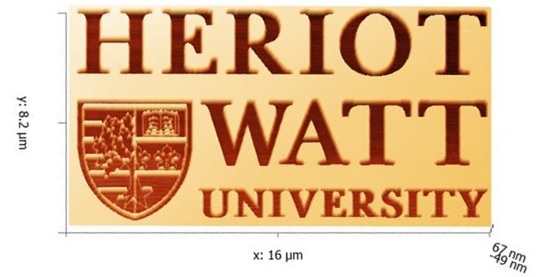Optical metasurfaces and Ultrathin Devices
|
|
|
Optical metasurfaces are engineered interfaces that contain a single layer or few-layer stacks of artificial planar structures (plasmonic or dielectric nanostructures) capable of manipulating light in a desirable manner by imparting local and space-variant abrupt phase, amplitude and polarization change. Advances in metasurfaces have led to various practical applications. Our recent work includes the realization of high-resolution grayscale image hidden in a laser beam, multichannel polarization-controllable superpositions of orbital angular momentum states, simultaneous control of holograms and twisted light beams, metasurface for optical rotation, helicity multiplexed broadband metasurface hologram, multifunction optical devices, longitudinal multi-foci lens, broadband vortex beam generator, helicity dependent directional surface plasmon polariton excitation and so on.
|
|
|
X. Zang, F. Dong, F. Yue, C. Zhang, L. Xu, Z. Song, M. Chen, P.-Y. Chen, G. S. Buller, Y. Zhu, S. Zhuang, W. Chu, S. Zhang, X. Chen, Polarization Encoded Color Image Embedded in a Dielectric Metasurface, Advanced Materials, 1707499 (2018). DOI: 10.1002/adma.201707499.
|
F. Yue, C. Zhang, X. Zang, D. Wen, B.D. Gerardot, S. Zhang, X. Chen, High-resolution grayscale image hidden in a laser beam, Light: Science & Applications, 7, 17129 (2018).
|
F. Yue, D. Wen, C. Zhang, B.D. Gerardot, W. Wang, S. Zhang, X. Chen, Multichannel polarization-controllable superpositions of orbital angular momentum states, Advanced Materials, 29, 1603838 (2017).
|
Dandan Wen, Fuyong Yue, Guixin Li, Guoxing Zheng, Kinlong Chan, Shumei Chen, Ming Chen, King Fai Li, Polis Wing Han Wong, Kok Wai Cheah, Edwin Yue Bun Pun, Shuang Zhang, Xianzhong Chen, ''Helicity multiplexed broadband metasurface holograms'', Nature Communications, 6, 8241 (2015).
|
L. Huang, X. Chen, H. Muhlenbernd, H. Zhang, S. Chen, B. Bai, Q. Tan, G. Jin, K. W. Cheah, C. W. Qiu, J. Li, T. Zentgraf & S. Zhang, "Three-Dimensional Optical Holography Using a Plasmonic Metasurface", Nature Communication, 4, 2808 (2013).
|
|
|
X. Chen, L. Huang, H. Mühlenbernd, G. X. Li, B. Bai, Q. Tan, G. Jin, C. W. Qiu, S. Zhang, and T. Zentgraf, "Dual-polarity plasmonic metalens for visible light", Nature Communications, 3, 1198 (2012).
|
L. Huang, X. Chen, H. Mühlenbernd , G. Li , B. Bai , Q. Tan , G. Jin , T. Zentgraf , and S. Zhang, "Dispersionless Phase Discontinuities for Controlling Light Propagation", Nano Letters, 12, 5750 (2012) .
|
Transformation Optics and Invisibility Cloak
|
All the invisibility cloaks demonstrated so far have relied on nano- or micro- fabricated artificial composite materials with spatially varying electromagnetic properties, which limit the size of the cloaked region to a few wavelengths. The macroscopic volumetric invisibility cloak constructed from natural birefringent crystals was first realized. The cloak operates at visible frequencies, and is capable of hiding three-dimensional objects of the scale of centimetres and millimetres, which is 3-4 orders of magnitudes larger than the optical wavelengths in all three dimensions.
|
|
|
|
|
|
Plasmonics and Biosensors
|
|
|
Biological materials like blood, tissues and organs now represent a daily routine material that our hospitals and research institutes handle for many preventive, therapeutic, and research applications. Our group is interested in how to develop a fast, cheap and at the same time very sensitive method to detect blood pathogens simultaneously. Bimetallic sliver/gold sensor chips are attractive since they combine the advantages of both sliver and gold layers. Bimetallic nanosensor chips with higher sensitivity and narrower response curves for surface plasmon resonance (SPR) biosensors were developed by improving surface quality of glass slides and optimizing film thickness. Recent years have also witnessed significant improvements in the fabrication of noble metal nanostructures, which has led to advances in the detection of molecular interactions near the nanoparticle surface through shifts in the localized surface plasmon resonance (LSPR) spectral peak. We have strong interest in the enhancement of sensor sensitivity and the integration of LSPR and optical fibres.
|
|
|
|
|
Large-Scale, Low-Cost Nanofabrication for Energy and Biomedical Applications
|
|
|
Traditional nanofabrication facilities (e.g., electron beam lithography and focused ion beam milling) make the conventional lithographic techniques unfavourable for large-scale nanostructure fabrication. Nanosphere lithography combines the advantages of both top-down and bottom-up approaches, providing a promising inexpensive fabrication tool for producing regular and homogenous arrays of nanoparticles with various sizes. To reduce the nanofabrication cost, we have developed a series of high-efficiency methods with modified nanosphere lithography. Periodic nanostructure arrays with various materials (e.g. gold, silver, silicon, PDMS and ceramics) and shapes (e.g. triangles, diamonds, bumps, bowls and pores) have been fabricated based on these approaches. The developed low-cost, high-efficiency approaches are promising for energy harvesting applications (e.g., LSPR nanomaterials) and biomedical applications (e.g., SERS).
|
|
|
[1] X. Chen, X. Wei, K. Jiang, "Large-scale fabrication of ordered metallic hybrid nanostructures", Optics Express, 16, 11888-11893(2008).
|
[2] X. Chen, X. Wei, K. Jiang, "Fabrication of high-aspect-ratio, size-tunable nanopore arrays by modified nanosphere lithography", Nanotechnology, 20, 425605 (2009).
|
|







